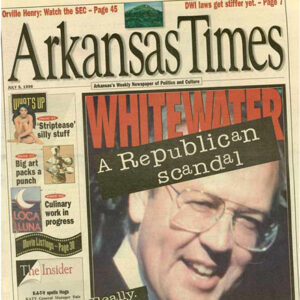calsfoundation@cals.org
Arkansas Times
The Arkansas Times is a widely read free periodical known for its liberal political stance as well as being an early adopter of news blogging in the state. The Times has achieved acclaim for its work on such stories as the Arkansas prison blood scandal and the case of the West Memphis Three. In 2013, the paper began crowdsourcing funding for in-depth investigative pieces.
In the fall of 1974, a group of five people led by Alan Leveritt set out to create an alternative media outlet for Little Rock (Pulaski County) that would offer investigative reporting and stories on local culture. Leveritt had gotten his start in the media business during his college days in the early 1970s at Little Rock University, now the University of Arkansas at Little Rock (UALR). He founded and operated an independent student newspaper, Essence. On its editorial page, Essence supported Leveritt’s personal politics, which embraced the ideas of libertarianism and the Young Americans for Freedom party. Using a $200 donation from a local bookstore, Leveritt and his associates published the first edition of the Union Station Times on September 5, 1974, so named because it was headquartered near Union Station in Little Rock. In July 1975, the name of the monthly publication was changed to Arkansas Times.
Early editions of the Arkansas Times monthly magazine were produced in its original office in an old house at 201 W. 2nd Street in Little Rock, with Leveritt serving as both editor and publisher. The Times later moved its offices to a house at 1111 W. 2nd Street. The house was seriously damaged in a fire set by an arsonist on June 21, 1979. All of the magazine’s business records perished in the fire; however, the staff was able to maintain its publishing schedule. Leveritt worked for a time as an obituary writer for the Arkansas Gazette but was fired during a reporters’ union movement in 1974 because his magazine was viewed as competing with the Gazette.
In 1982, the Times survived another serious financial setback. A few weeks after publishing a story on the worst politicians in Arkansas, the Times was audited by the sales-tax division of the Arkansas Department of Finance and Administration, which claimed that the magazine had failed to collect point-of-sale tax on its product and now owed the state $10,000. Under Arkansas law at that time, newspapers were not required to collect and remit sales tax. Magazines, however, were required to collect and remit the tax. In a subsequent lawsuit, the Times contended that the state could not discriminate between a newspaper and a magazine and that, therefore, it did not have to collect and remit sales taxes. The case eventually was heard before the U.S. Supreme Court, which decided in favor of the Times.
The magazine became known for its decidedly liberal stance on political issues and its willingness to pursue investigative reporting. One story from 1975 concerned allegations that the Little Rock Police Department was trying to place marijuana in the car of Jim Guy Tucker, who was at that time prosecuting attorney for Pulaski and Perry counties (and who would later become state attorney general, congressman, and governor). Times editor Bill Terry narrowly missed being run over by a private detective who was involved in the case. The detective had stolen from Times staffers a video tape with evidence of the crime, and Terry had stepped in front of the detective’s car to stop him from leaving with the tape.
After the demise of the daily Arkansas Gazette newspaper in 1991, former Gazette staffers such as Max Brantley, Doug Smith, and Ernie Dumas became the editorial voice of Arkansas Times, which sought to counterbalance the conservative editorial stance of Little Rock’s surviving daily newspaper, the Arkansas Democrat-Gazette. The Arkansas Gazette’s celebrated editorial cartoonist George Fisher also contributed to the Times until his death in 2003. “I went out and raised $680,000 to convert the monthly magazine into a weekly,” Leveritt recalled in an article that appeared in the fortieth-anniversary edition of the Arkansas Times in September 2014. “We wanted to keep the Gazette’s voice alive in the community.”
Brantley served as the first editor of the Times when it began publishing as a weekly newspaper in May 1992. “You had all these potential readers that you could add to your circulation base who were disaffected daily newspaper readers who were not particularly happy that all they had left was the Arkansas-Democrat Gazette to read,” Brantley told an interviewer for an oral history project with UALR. Aside from counterbalancing the conservative leanings of the Arkansas Democrat-Gazette, the Arkansas Times also acquired a reputation for investigative journalism, especially with regard to Mara Leveritt’s reporting on law enforcement and prison-related issues. Lindsey Millar became editor-in-chief of the Times in 2011.
The Times’ parent company, Arkansas Times Limited Partnership, also produces other magazines and newspapers, including El Latino (a Spanish-language weekly), Savvy Kids (a family magazine), Arkansas Wild (an outdoors magazine), and its annual Native’s Guide to Pulaski County. The Times created a sister publication, Arkansas Business magazine, in 1984, but the two companies eventually became separate entities. In January 2017, Millar launched the Arkansas Nonprofit News Network (ANNN), described as a “nonpartisan news project dedicated to producing journalism that matters to Arkansans.” The ANNN seeks to publish and broadcast deep examinations of crucial topics and develop major investigative series. The publication’s crowd-funded work exploring the ExxonMobil Pegasus pipeline rupture in Mayflower (Faulkner County) in 2013 and investigating the state child welfare system in 2015 serves as a model for the ANNN.
In late 2018, Millar announced that the Times would be changing format from a weekly newspaper to a monthly glossy magazine, augmented by an increased online presence. The first issue in the new format appeared on January 31, 2019. In May 2023, Millar stepped down as editor-in-chief, and Austin Bailey replaced him, with Stephanie Smittle, previously the managing editor, now serving as the top editor of the monthly magazine.
For additional information:
“45 Years of the Arkansas Times.” Arkansas Times, September 2019, pp. 31–63. Online at https://arktimes.com/news/cover-stories/2019/08/30/45-years-of-the-arkansas-times (accessed June 13, 2023).
Arkansas Times. http://www.arktimes.com/ (accessed June 13, 2023).
Arkansas Times, fortieth anniversary issue, September 18, 2014. Online at http://www.arktimes.com/arkansas/the-40th-anniversary-of-arkansas-times/Content?oid=3460507 (accessed June 13, 2023).
Leveritt, Alan. “First Day on the Job.” Arkansas Times, January 2024, pp. 9–11. Online at https://arktimes.com/arkansas-blog/2024/01/13/from-the-vault-alan-leveritts-first-day-on-the-job (accessed January 15, 2024).
Massey, Kyle. “In a Besieged News World, Aiming for Impact, Not for Profit.” Arkansas Business, February 13–19, 2017, pp. 1, 12–13. http://www.arkansasbusiness.com/article/115521/arkansas-nonprofit-news-network-aiming-for-impact (accessed June 13, 2023).
UALR Seminar in Public History (HIST 7391) Files on the Arkansas Times, 2013. Center for Arkansas History and Culture. University of Arkansas at Little Rock, Little Rock, Arkansas.
Rod Lorenzen
Butler Center for Arkansas Studies
 Divergent Prosperity and the Arc of Reform, 1968–2022
Divergent Prosperity and the Arc of Reform, 1968–2022 Mass Media
Mass Media Arkansas Times Staff
Arkansas Times Staff  Arkansas Times Coverage of Whitewater Scandal
Arkansas Times Coverage of Whitewater Scandal  Max Brantley
Max Brantley 




Comments
No comments on this entry yet.